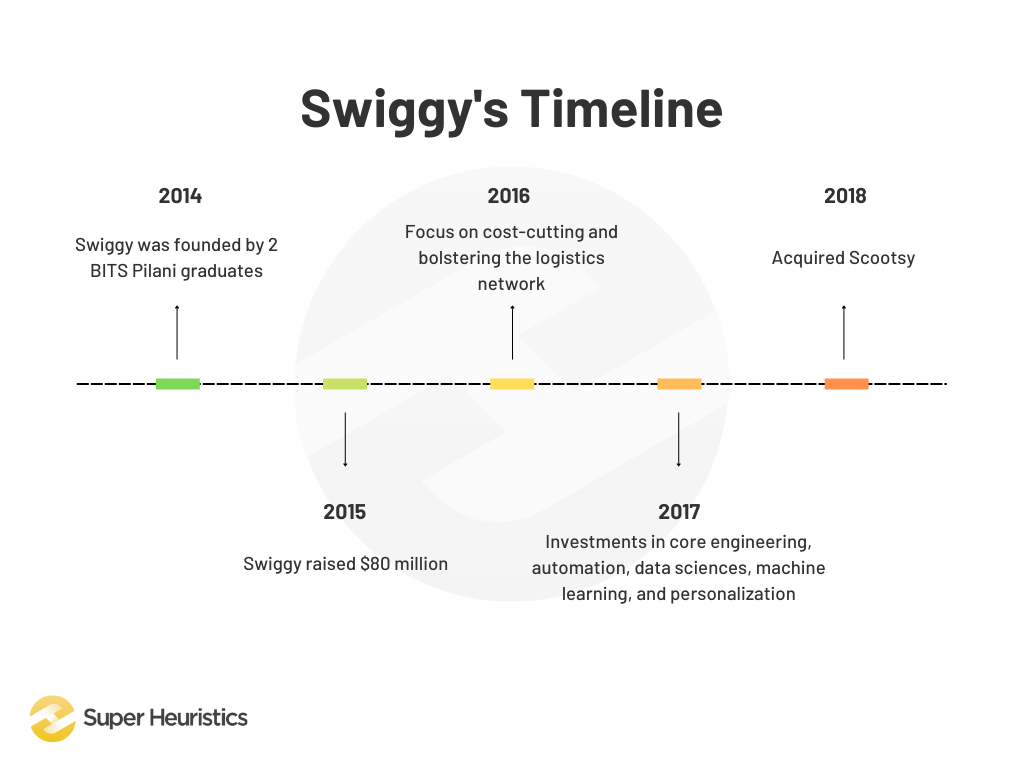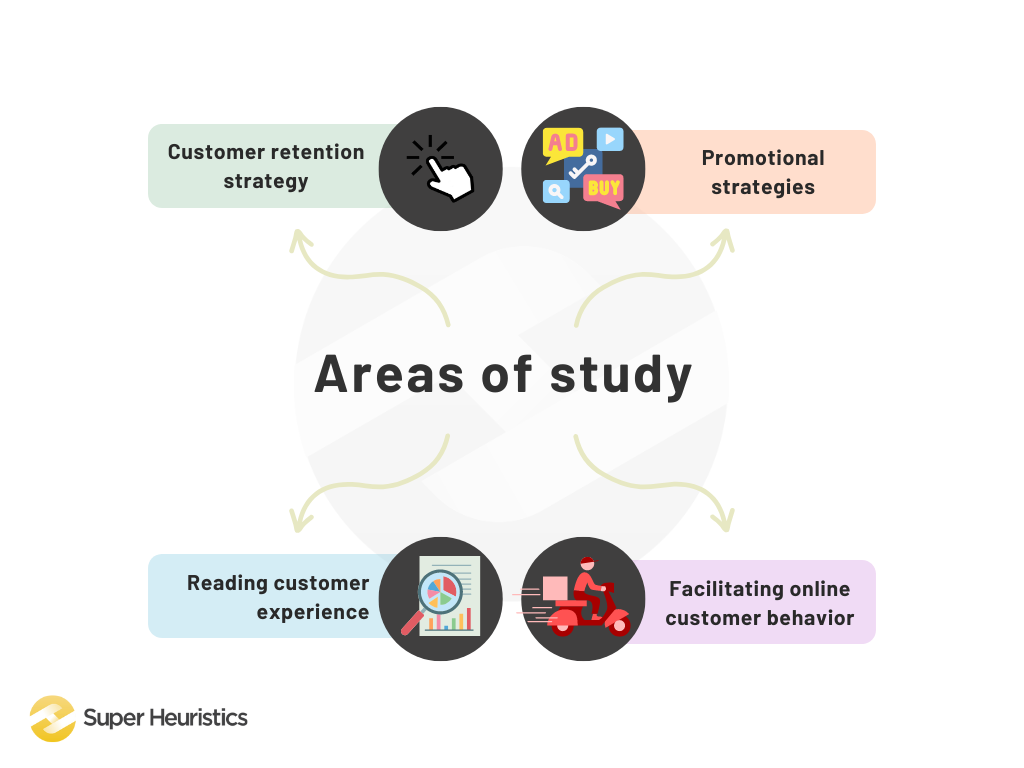We have already studied the theory of consumer behavior. You can find the full list of chapters here. It is now time to conclude with a bang! This is a bonus chapter to discuss a consumer behavior case study.
When you ask someone if they want to order food at home, the most common response is, “Chal Swiggy karte hain.” Founded in 2014 as an online food delivery service, Swiggy has become one of the most popular apps in India today.
No business can succeed without pleasing its customers. What better way to satisfy consumers than by studying consumer behavior?
It is common to see Swiggy sway us toward ordering food instead of eating at home with its eye-catching notifications about delicious food. But how does Swiggy know exactly what you’re craving each and every time?
This consumer behavior case study will try to demystify Swiggy’s success in India, how it has managed to defeat the competition, and how it deploys consumer behavior analytics to its advantage.
Let us begin with a quick history lesson.
Swiggy’s history
There is no better way of starting a case study than understanding how the organization started and how it has grown. In this consumer behavior case study, we will use the same method.

Swiggy was founded in 2014 by two BITS Pilani graduates, Sriharsha Majety and Nandan Reddy. It first tied up with some eateries in Bangalore and started delivering food to customers in under forty minutes in spite of the Bangalore traffic!
At that time, there was no established business that was catering to this particular sector. Swiggy’s competitors were struggling, and at the beginning, so was Swiggy.
It was difficult to get restaurants to partner with it. So, Swiggy made its logistics network faster, easier, and streamlined with a widespread and strong network of local delivery boys to make it stand apart in the online food delivery scenario. Soon, restaurants saw the perks of joining Swiggy (increased sales) and joined forces with it.
Swiggy raised $80 million in funding by 2015. After investors began to invest in the startup, the platform began to experience great heights. The food platform had partnered with over 100 restaurants by the end of 2015, and it was delivering over 70,000 orders each month.
Swiggy experienced losses 65 times in March 2016. Swiggy made the decision to focus on cost-cutting and bolstering the logistics network in April 2016. In order to better understand its customers' needs and improve its operations, Swiggy made investments in core engineering, automation, data sciences, machine learning, and personalization in 2017.
By the end of December 2017, Swiggy had expanded to more than ten cities, had partnerships with more than 20,000 restaurants, and was recording a staggering 4+ million transactions per month on their balance sheet. Swiggy acquired Scootsy in 2018 to expand its operations in industries like groceries, fashion, stationery, and other necessities, as well as to better serve its customers' needs and to improve its operations in 2017.
By 2019, Swiggy had a daily order volume of about 1.4 million, a delivery team of 45,000 agents, 1,30,000+ restaurant partners, and a presence in more than 325 Indian cities.
In 2020, when the pandemic hit, we all had massive cravings for restaurant food. The few of us who were still not using online food delivery platforms downloaded our only savior - Swiggy. The relief when the shahi paneer and butter naan got delivered…
The next step in studying the consumer behavior case study of Swiggy is understanding its consumer behavior strategies. Let’s take a look at them.

Swiggy’s strategy for customer retention
If you compare the notifications/ads that you and your friend get from the Swiggy app about four to five times a day, you will find some similarities. However, if you and your friend like completely different cuisines, you will notice the differences too.
For example, when I get a notification from Swiggy, it usually advertises burgers or fries. If you are an avid consumer of Indian food, you might get ads for samosas or chhole bhature, if you like Chinese food, you might get ads for manchurian and noodles, and so on.
In this way, Swiggy uses a hyperlocal marketing strategy. One definition of hyperlocal marketing is “a strategy that targets potential customers who are close to your business location and looking for products and services like yours.” (PlotProjects)
This location is very specific. Swiggy tracks your location and suggests restaurants within a few kilometers radius. For example, if you live in North Delhi, you would rarely be suggested a restaurant in South Delhi. If so, you will be informed in advance that delivery fees would be higher than normal due to increased distance.
Swiggy uses machine learning to track users’ past purchases, search history, and even where they usually order from to make super-personalized ads. The ads are usually followed by a coupon if the consumer taps on the ad and visits the suggested restaurant’s page.
Using machine learning and these super-personalized ads, Swiggy was able to significantly reduce its customer acquisition cost.
Swiggy’s promotional strategies
Let’s talk about those push notifications again. Swiggy uses these notifications to retain your interest in its services and to increase your time spent on the app.
But what about Swiggy’s promotional campaigns? We won’t just discuss what Swiggy does to retain old customers in this consumer behavior case study. In this section, we will discuss how Swiggy promotes its services.
Swiggy’s promotional campaigns are both engaging and participatory. The posts are humorous, appealing, of outstanding quality, and lighthearted. Ingenious puns and one-liners were used in campaigns like #EatYourVeggies, #SuperSwiggy, and #EarnYourCheatMeal to promote healthy eating.
Apart from these campaigns, Swiggy also gets its services promoted by influencers. Across the board, Swiggy is active on social media. They also publish humorous blogs that make fun of current events in order to promote the company's goals and services.
Daily emails are sent by Swiggy to its clients. They use eye-catching images, smart slogans, and mind-blowing deals to grab customers' attention. Customers like us then increase Swiggy’s CTR by clicking on the links and notifications to enter the sweet sweet world of tasty food.
How Swiggy reads customer experience
When you log on to Swiggy from a different location, you first choose a delivery address, decide the cuisine you would like to have, scroll through the endless list of available restaurants, and finally scroll through the menus of these restaurants.
You do all this while keeping in mind your budget for both time and money. As a result, you end up spending too much time deciding what to eat and ultimately settling for something that can reach you within less than half an hour. Wouldn’t you love it if Swiggy just offered you some pre-customized carts that you can order in a jiffy?
Well, this is not only true in this consumer behavior case study. Swiggy is actually planning to offer these pre-customized carts with two items each! It is planning to incorporate these changes in upcoming versions of the mobile application.
With the machine learning tools already in place to create echo chambers of recommended restaurants with your favorite cuisines, Swiggy will use Food Intelligence (FI) technology to make consistent combinations of two dishes each. Consumers will be able to order these directly without having to give too much thought to what to eat.
For example, if Swiggy has the data to show that you like Chinese food, it might show you a pre-made cart with noodles and manchurian. If you like North Indian food, it might offer you a cart with shahi paneer and butter naan.
How Swiggy facilitates online consumer behavior
SInce the pandemic in 2020, we have all started craving good experiences. As an Indian, I feel like no experience is superior to having good food and good company. Swiggy solves one of these pressing issues - providing good food at your convenience.
However, we also love the comfort of knowing that we have a single trustworthy medium to fulfill at least a few of our basic needs. Apart from delivering food, Swiggy ventured into grocery delivery, in-city courier services, and even delivering items from small businesses.
The pandemic made us realize how fickle the physical environment is. It didn’t take us long to try new grocery delivery apps like Big Basket and Grofers. However, we wanted a guarantee from the application, and we also wanted free space in our phones.
When Swiggy ventured into the grocery division, it was a huge respite for some. Swiggy had already established its network and customer base. All it needed to do was partner with supermarkets and our favorite kiranas.
With the guarantee to deliver groceries to the comfort of our homes in less than half an hour, Swiggy quickly became one of our favorite apps for ordering groceries. Since we could get rid of apps that solely delivered groceries, we didn’t mind the free space on our phones either!
The second division Swiggy got into was the intra-city courier service, which Swiggy named Swiggy Genie. You can order food from a restaurant, get your groceries, and even send items to someone you’re too busy to meet in the same city.
This service was especially helpful for people who worked late hours and missed their mom’s rajma chawal. Their moms could easily send lunch to them without having to travel.
Swiggy has another division now called Swiggy Minis. It supports small businesses in major cities in India by facilitating delivery to customers, giving them an online store feel with its own mobile application interface, and making it easier for customers to discover them.
Since it’s a consumer behavior case study, we will now conclude by analyzing what a huge role consumer behavior plays in Swiggy’s strategies.
Analyzing the role of consumer behavior
In a nutshell, Swiggy observed online consumer behavior and converted its application into a one-stop shop for almost all the daily needs of Indian consumers. It understood the need for trust and credibility for consumers in India while also understanding the need for comfort even when shopping online.
Slowly, step by step, Swiggy created a platform for consumers to order food, groceries, and meat, send and receive intra-city couriers, and order items from their favorite small businesses. It shaped its promotional strategies to suit the needs of the young Indian consumer. Its promotions are flashy and engaging, and its offers are irresistible.
It is great at retaining customers, not only because of the variety and convenience it offers but also because of its quick and satisfactory customer service. With the pre-customized carts, it will ensure that even more customers are retained.
In all, Swiggy is one of the biggest food delivery giants in the country because of its exceptional use of consumer behavior data it collects and consumer trends prevalent in the market.
Conclusion and key takeaways
In this chapter, we discussed the consumer behavior case study of one of the biggest food delivery giants in the country - Swiggy. To recap, we looked at how Swiggy uses consumer behavior in its following strategies:
- Customer retention strategy
- Promotional strategy
- Reading customer experience
- Facilitating online consumer behavior.


Good4u.